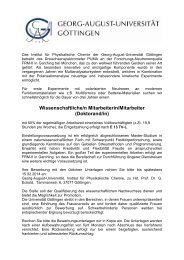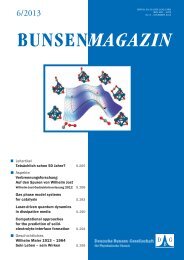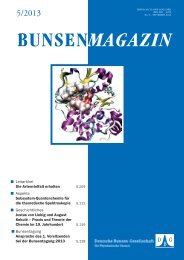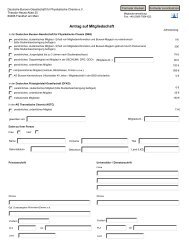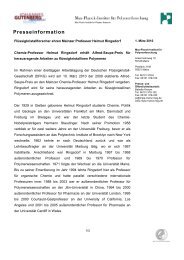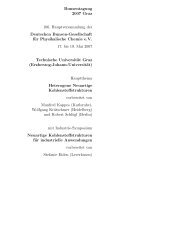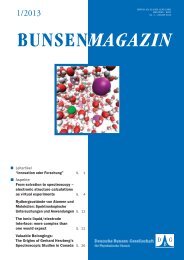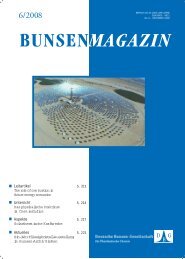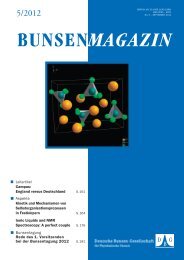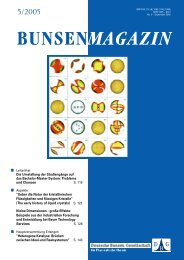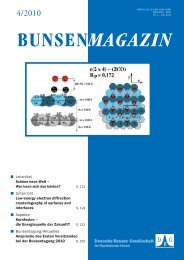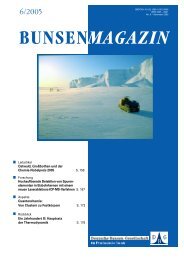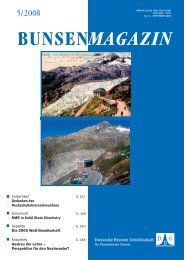BUNSENMAGAZIN - Deutsche Bunsengesellschaft für ...
BUNSENMAGAZIN - Deutsche Bunsengesellschaft für ...
BUNSENMAGAZIN - Deutsche Bunsengesellschaft für ...
Sie wollen auch ein ePaper? Erhöhen Sie die Reichweite Ihrer Titel.
YUMPU macht aus Druck-PDFs automatisch weboptimierte ePaper, die Google liebt.
UNTERRICHT<br />
tautomeric forms (keto/enol) of 1-n-butyl-5-(4-nitrophenyl) barbituric<br />
acid are found, self-aggregation due to complementary<br />
hydrogen-bonding favours only one tautomer in the solid-state.<br />
The resulting dimeric complex tolerates treatment with rather<br />
strong bases (e.g. 1,8-diamino-naphthalene) but is broken in<br />
the presence of adenine-mimicking diacetamido-pyridin. After<br />
tautomeric rearrangement of 1-n-butyl-5-(4-nitrophenyl) barbituric<br />
acid, a 1:1 complex with diacetamido-pyridin is formed.<br />
Using 60 kHz MAS and our highest available magnetic fi eld<br />
( 1 H, 850.1 MHz@20 T), we could unambiguously identify the<br />
structure of this complex. Previous attempts at lower fi elds and<br />
lesser MAS rotation frequency (e.g. 30 kHz MAS, 1 H, 700.1<br />
MHz@16.4 T) did not provide suffi cient resolution, thus demonstrating<br />
the benefi ts from ongoing developments of NMR<br />
hardware. 55 The interpretation of experimental chemical shift<br />
data was supported by ab initio DFT-based quantum chemical<br />
computations. 56<br />
Figure 13: 1 H- 1 H double-quantum MAS NMR spectrum of the chromophordiacetamido-pyridin-complex<br />
at 850.1 MHz and 60 kHz MAS. The relevant<br />
OH/NH-crosspeaks are highlighted. At the right, a DFT-optimized model geometry<br />
of the complex is given. (Gaussian03//BLYP/6-311++G(2df,2pd)). 56<br />
Though for many host-guest complexes 57 structural data from<br />
single-crystal X-ray analysis is available, proton positions are<br />
commonly refi ned according to known geometries rendering<br />
them rather ill-defi ned. In this case, ab initio DFT-based structure<br />
refi nement is mandatory to account for experimentally observed<br />
1 H chemical shifts. 58 Furthermore, we could show that<br />
a comparison of X-ray structures with NMR data is only feasible<br />
at comparable temperatures, particularly in cases where<br />
dynamic effects such as exchange of protons along hydrogen<br />
bonds occur. This, for instance, has been observed for α-truxillic<br />
acid where the 1 H MAS NMR spectrum displayed only an<br />
averaged peak at 14 ppm for the carboxylic acid proton, while<br />
the respective 13 C-CPMAS spectrum revealed two carbonyl car-<br />
Figure 14: (left) Static 2 H NMR spectrum of α-truxillic acid. The quadrupolar<br />
splitting of 117 kHz indicates a two-site jump in the fast limit. (right) Xray<br />
structure at 350 K revealing 50:50 occupancies of the proton along the<br />
OH---O=C hydrogen bond. 59<br />
68<br />
BUNSEN-MAGAZIN · 11. JAHRGANG · 2/2009<br />
bons resonating at 178.9 ppm and 182.3 ppm, respectively.<br />
Since 2 H nuclear quadrupolar couplings are a sensitive probe<br />
for the asymmetry of hydrogen bonds, we acquired a static<br />
2 H NMR spectrum yielding a (quadrupolar) Pake pattern with<br />
a quadrupolar splitting of 117 kHz (cf. fi gure 14), which indicates<br />
a two-site jump of the proton along the hydrogen bond<br />
in the fast limit. This could be confi rmed by high-temperature<br />
X-ray analysis at 350 K revealing 50 : 50 occupancies of the<br />
corresponding COOH proton within the OH---O=C hydrogen<br />
bond. 59<br />
The structure and dynamics of the protons is particularly interesting<br />
in proton conductors. In a recent study, we applied<br />
solid state 1 H (and 2 H) -NMR to a promising class of almost<br />
anhydrous proton conductors that are aimed at generating<br />
improved membranes for high-temperature fuel cell operation.<br />
In anhydrous systems, proton conduction should not rely<br />
on the presence of water or other small molecules (like in<br />
the industry benchmark compound Nafi on Ò ), but should originate<br />
from so-called structural diffusion among the protogenic<br />
groups. 53 One representative compound is given by polyvinyl<br />
phosphonic acid (PVPA). The PO(OH) 2 protons resonate at<br />
10.6 ppm, thus indicating hydrogen-bonding of moderate<br />
strengths. 1 H MAS NMR spectra at increasing temperatures<br />
display substantial line-narrowing for this peak while its chemical<br />
shift remains nearly constant indicating a fast exchange<br />
among non-equivalent proton sites. In addition, static 2 H NMR<br />
spectra at variable temperatures ranging from 250 to 390 K<br />
were also recorded, and revealed a complete averaging of the<br />
initial (quadrupolar) Pake pattern to an isotropic line. In both<br />
cases, apparent activation energies were extracted assuming<br />
an Arrhenius-type behaviour of the proton mobility. From 1 H<br />
NMR data, an apparent activation energy of 25 kJ/mol is obtained<br />
while 2 H NMR data yields 38 kJ/mol, which is in good<br />
agreement with an apparent activation energy of 45 kJ/mol<br />
extracted from an analysis of temperature-dependent proton<br />
conductivities in the bulk sample. 60 Nevertheless, the almost<br />
complete averaging of the quadrupolar Pake pattern at high<br />
temperatures is not easy to explain. A geometric scenario<br />
which could lead to such an averaging would be that the principal<br />
axis of the quadrupolar tensor of the jumping deuteron<br />
is aligned at the magic angle with respect to the magnetic<br />
fi eld, a condition that is obviously diffi cult to achieve in a bulk<br />
polymer sample. A Car-Parrinello Molecular Dynamics (CPMD)<br />
simulation on a model fragment of PVPA, however, not only<br />
accounts for the average chemical shift, 61 it also revealed a<br />
broad distribution of quadrupolar tensor orientations for the<br />
deuterons after a run of only 15 ps or so. The average quadrupolar<br />
splitting resulting from this is only 10% of the coupling in<br />
the rigid limit, thus indicating a complex exchange behaviour<br />
of the protons. 61<br />
3.2. SHAPE CONTROL<br />
Molecular recognition due to hydrogen-bonds also governs<br />
the selective incorporation of small solvent molecules into<br />
calix[4]hydrochinone-based nanostructures. The extended tubular<br />
assemblies are formed from a monomer-water mixture<br />
where the water molecules act as bridging units. 62



